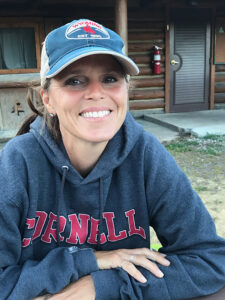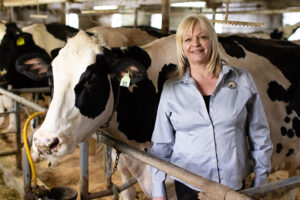Stories by Stefan Yablonski
REAL ESTATE
Area Realtors Keeping an Eye on Interest Rates
Buying or selling real estate is one of the most important decisions people will make. Since 2022, the Oswego County area has remained a seller’s market, according to an Oswego Housing Market report.
That means prices tend to be higher and homes sell faster.
In 2023, homes in Oswego sold for 11.1% more than they did in 2022. That percentage translates to more than $15,000. The median sold price was $150,000.
“Real estate for sellers in 2023 was extremely strong and I foresee that continuing for 2024,” said Karen A. Hammond of Hunt Real Estate. “The sellers that listed their house at a fair marketable price, saw their houses selling very quickly and some still with multiple offers.”
What is keeping this real estate market strong is there is still great number of buyers still looking for homes. The largest hurdle for buyers in 2023 and still seeing it to continue a bit in 2024 is the lack of inventory of houses, she added.

“The past several years have proven to be a very tough environment for buyers, particularly buyers just entering the market for the first time — as it has been an environment with low inventory,” said Patrick Haggerty, associate broker with Century 21 Leah’s Signature. “It has been a very competitive environment in which the demand has exceeded the supply of homes creating many multiple offer scenarios, which has caused prices to increase at a rapid rate.”
Additionally, 2023 saw a sharp increase in interest rates, which has created an even tougher situation, where buyers are not only paying more for homes, but also paying more for the money they are borrowing to buy homes, according to Hammond.
Mortgage rates are still elevated, higher home prices and low housing availability has made it difficult for new homeowners entering the market, agreed Leah Haggerty, owner-broker at Century 21 Leah’s Signature..
“The local real estate market has been extremely strong for sellers since 2020,” said Teri L. Beckwith, licensed real estate salesperson with Hunt Real Estate, ERA. “Due to the amount of buyers still in need of a home, we predict this to continue throughout 2024,”

The prediction of interest rates dropping will certainly guarantee a great 2024, she added.
“If mortgage rates continue to come down as forecasted and the market opens up with more confident sellers, then our spring market should be good,” Leah Haggerty said. “It’s difficult to predict when so many factors are involved.”
“It is hard to predict exactly what the policy will be moving forward on interest rates. But, if they continue to stay elevated, it may continue to keep homes off of the market in which the homeowners have, as an example, a 3% or 4% interest rate,” Patrick Haggerty added. “Homeowners that would ideally like to downsize or upsize but have such a favorable interest rate as 3% or 4%, are deterred from selling and then buying another home at a 6% or 7% interest rate, which further restricts the supply of available houses.”
“There was slight lull in late summer and fall — fall when interest rates increased in 2023. But after the initial shock that rates where not going back to the low of 2% or 3% buyers adjusted to new rates and started searching again for their new homes,” Hammond said. “I believe the interest rates for 2024 will stay around the rate of 6% to 7 % and no major increases in the interest rates.”
“A positive factor for our area is the Micron effect. Builders and investors are just starting to act upon the future possibilities,” Leah Haggerty added.
FARMING
Farmers Still Facing a ‘COVID Hangover’
New York is a leading agricultural state, worth $5.75 billion in revenue 2017, the latest data provided by USDA’s National Agricultural Statistics Service, the NYS Department of Agriculture and Markets and Farm Credit East.

“Speaking from smaller scale operations like ours, one of the biggest challenges is increasing costs of supplies, vet bills, feed and so on,” said Heather DelConte of Black Creek Farms in Volney.
Creating a much smaller profit margin, small-scale or family-run farms usually boast high quality products that are raised or grown in humane, conscientious and sustainable ways, she added.
“There is definitely a market for that, but ever increasing costs of inputs threaten the viability of those businesses,” DelConte said. “Additionally, the clear evidence of changing and unpredictable climate factors also hurt the smaller farmer.”
Another big challenge for CNY farming, according to DelConte, is that the average age of producers in New York hovers near 60 years old.
“It’s very difficult for young people, especially those without farming backgrounds, to get started,” she said.
There is a whole host of issues that challenge much larger scale operations.

“At the start of a new year, many people look for ways to live a healthier lifestyle — and locally produced dairy products, like milk, cheese and yogurt is one of the best ways to do just that,” according to American Dairy Association North East president Audrey Donahoe of Clayville.
“Dairy provides nutrients we all need to grow and maintain stronger bodies and minds. And, with milk containing 13 essential nutrients for around a quarter a serving, it’s an affordable option for families.”
The best way people can support dairy farmers, she said, is as simple as continuing to purchase and enjoy their favorite dairy products.
It’s easy to check where your milk was processed — just look for the number 36 at the top of the jug or carton. That means it was processed in New York state.
Milk is produced every single day of the year; not many foods can say that, she added. “For example, milk from my cows that leaves my farm today will be on store shelves in Albany tomorrow.

From the dairy side, it’s been a big challenge coming out of the COVID-19 time, according to Bruce Gibson, president of the Oswego County Farm Bureau board and a managing partner of Locust Hill Dairy Farms in Lacona and Ellisburg.
“It’s like a COVID hangover, if that makes sense,” he said. “2020 was rough for everybody; 2021 and 2022 weren’t too bad in some respects. But there was inflation that crept in and began to ramp up. For the most part I would say that our products did well to keep up.”
In 2023 and 2024, so far, while the rate of inflation has decreased it’s still a bit higher than a lot of people grew accustomed to; the products that we produce have retreated back toward more traditional pricing.”
“Inflation has definitely outpaced what we received for milk. I think that’s probably true for a lot of the other farmers — the grain croppers, the guys growing soy bean and corn — look at the futures markets in those commodities they’ve come way down. They’re going to feel the pinch,” he added.
Back to dairy, when the grain goes down the feed gets cheaper and “that does soften the blow on some of the other parts, things that we use,” Gibson said. “It’s a little bit of a mixed bag, but I would say that we’re on the short end of he stick.”
“The other thing that I don’t see a lot of people talking about — and this would vary from producer to producer — interest rates. A guy going to buy a tractor maybe borrows some money to do that … that has gone up quite a bit. If you’re a farmer who is 35 years old you don’t remember interest rates like they were. But if you’re 55 you definitely do — but it doesn’t make us feel any better. It’s like homebuyers – people are like ‘whoa look at these rates.’ When your product is settling back … and you’re paying additional interest on top of that, it’s a double whammy,” he said.
Overtime Pay Threshold Already in Place
The phased-in, gradual reduction in the overtime pay threshold for farmworkers began Jan. 1, with the threshold set at 56 hours per week. It was 60 hours previously.
The process will continue with the threshold limit reducing by four hours every other year until reaching 40 hours per week in 2032.
“Our agricultural industry is the backbone of New York, feeding people across the country, and farm workers are an essential piece in that process,” said New York State Department of Labor Commissioner Roberta Reardon. “Introducing a phased transition allows farmers the necessary time for adjustments while protecting the farm workers who are a huge part of putting food on New Yorkers tables. These regulations reinforce New York state’s ongoing dedication to its workers.”
“People think, ‘Oh my god, farmer workers don’t get paid overtime until they get to 60 hours.’ But they don’t realize that in 46 other states there was no overtime at all,” said Bruce Gibson, president of the Oswego County Farm Bureau board. He is also a managing partner of Locust Hill Dairy Farms in Lacona and Ellisburg.
“On our farm I don’t know that we find it such a problem that New York wants us to pay overtime as much as the states we are competing with — the other dairy states like Wisconsin, Michigan Pennsylvania. They ship to the same processors that New York dairy farmers do. They don’t have that cost in their structure; it doesn’t exist.”
It’s just something to consider that affects the bottom line, he added.
“The crop guys, their windows are so condensed. Their planting windows are short; their growing season is shorter than other parts of the country. They have got to do the job when the weather allows. That leads to long hours and overtime. It’s something that New York farmers bear that those in other states don’t.”
TOURISM
Oswego County Tourism Launches New Website
Visitors and residents alike are invited to explore Oswego County Tourism’s new website: https://visitoswegocounty.com.
The re-designed site has updated content, new features and enhanced accessibility for desktop and mobile devices.
“Our new website will make it easier than ever for visitors to plan their trip to Oswego County,” said Oswego County Legislator Mary Ellen Chesbro, District 10, chairwoman of the Legislature’s Economic Development and Planning committee. “The website is easily accessible on computers, tablets and cell phones, providing a more user-friendly experience than our previous site. Our homepage features an eye-catching video displaying the many things Oswego County has to offer throughout the year and the website design allows users to easily navigate our many attractions and events.”
The website continues to promote Oswego County’s rich history, world-class fishing, unique attractions, charming accommodations and more.
New features include an interactive map displaying attraction locations and a blog section with articles written by local experts and tourism staff highlighting various activities, events, restaurants, museums, shops and more.
“There are a lot of exciting things coming up in Oswego County, and we’re glad to have an updated website to help showcase everything there is to see and do here,” said Daniel Breitweg, deputy director of the Oswego County Community Development, Tourism and Planning Department. “The website will continue to change and expand as we make improvements and add more features. One example is our interactive map, which will be updated seasonally to show visitors optimal attractions for that time of year.”
Visitors can stay up to date on Oswego County happenings by checking the events page or viewing Oswego County Tourism’s social media pages, which are linked on the homepage of the website.
Weekly fishing reports and winter trails reports are also accessible on the site, as well as Oswego County guides. Users can order physical copies of the Fishing and Hunting Guide and the Visitor Guide online or download the digital versions.
Oswego County guides can also be ordered by calling Oswego County Tourism at 315-349-8322 and fishing and winter trails reports can be heard by calling 1-800-248-4FUN (4386).
THE Ys
Oswego YMCA Membership Surpasses 1,200

The Oswego YMCA amplified its impact as membership grew to more than 1,200 members in 2023 with more than 41,800 visits throughout the year.
“More importantly, the organization provided more than $87,000 in scholarships to provide access to many programs and services for those in our community in need,” Oswego YMCA CEO Cheryl Baldwin said. The Y fosters connections through family programs and community events such as Healthy Kids Day, Kids Night Out, Family Nights, the Pumpkin Festival and other holiday events, she added.
Last summer, the Y provided more than 106 children with the opportunity to be creative, use their imaginations and foster friendships during Oswego YMCA Summer Camp programs.
The Oswego Y’s Play and Learn Center was visited by more than 3,600 young children in 2023, supporting families and providing opportunities to 7,084 youth and teens to stay active and engaged through Oswego YMCA youth sports and enrichment programs, including free after school open gym programs and the YMCA Youth Center.
More than 3,693 adults participated in YMCA events like the Harborfest 5k and 10k, Reindeer Run, wellness challenges, group fitness classes, pickleball and adult sports leagues to support individuals’ health and well-being.
Filling a critical need in the area, the Oswego YMCA continues to offer licensed before and after school childcare programs for K-6 grades in the Oswego city and Mexico school districts and is expanding in 2024-25 to other school districts to help meet the urgent childcare needs in Oswego County. The program currently serves more than 240 children for families requiring before and after school care.
As the Oswego YMCA looks to the future, the organization reflects on “the past year of positive opportunities we were able to provide to our Oswego County area youth, families and individuals,” Baldwin said.
These highlights are just a snapshot of the community impact and outstanding accomplishments the organization has celebrated over the past year, she added.
“Our success only reflects the outgrowth of the generosity, friendship and involvement of our community — and we’re excited about the opportunities that lie ahead,” said Baldwin.
She stressed that all the positive outcomes are only possible through the dedicated staff, committed volunteers and generous supporters of the Y — “They have all been responsible for our ability to make a meaningful difference in the lives of all those we serve.”
Fulton YMCA Expanding Outdoor Programming

The Fulton Family YMCA currently offers 24-hour fitness center and gymnasium access, said Amy Leotta, executive director.
The Y also offers a competitive swim team, swim lessons, aqua aerobic classes, group exercise classes and personal training, she added.
“We also offer before and after-school childcare in the Fulton City School District and a full daycare center offered onsite,” she said.
“In 2024, we are planning on expanding our outdoor programming, including kayaking and archery,” she continued. “We’re fostering community relations and working to improve our facility.”
The YMCA movement has always held a strong focus on youth development and healthy living.
The Y also believes that a part of that movement includes different recreational experiences outside of the traditional fitness center and group exercise experiences. “The Fulton YMCA has recognized the need for our rural communities to have opportunities to use our natural surroundings as a way of exercise,” Leotta said.
“The Fulton YMCA’s location is set perfectly to offer such experiences. This past summer, we launched a kayaking program for our community that included all ages.”
This was a collaboration between Oswego Expeditions, the YMCA and Fulton City’s Parks and Recreation.
“We had seed money for this program through funding from the Oswego City-County Youth Bureau and the New York State Office of Children and Family Services,” she said.
Due to the success of this program, the YMCA wants to continue to offer outdoor recreational activities.
“In the coming year, we would like to offer snowshoeing on the city trails behind the YMCA, offer programming throughout city parks and launch a beginner archery for youth,” she said. “We hope that each year we can continue to grow and bring in unique recreational opportunities for all ages at our facility and throughout the community.”
NONPROFITS
Area Nonprofits Emerging From the Pandemic

Nonprofits continue to work diligently to recover from the challenges of the pandemic.
Most notable are the arts organizations that are struggling to reclaim their audiences.
“In general, job stability is a challenge for nonprofits, in terms of acquiring and retaining staff. Many nonprofits are short-staffed and are having trouble keeping up with programming demands,” said Frank Ridzi, vice president of community investment for the Central New York Community Foundation.
For instance, housing continues to be a large need for residents and nonprofits working in this area are struggling to find and retain the staff needed to keep good quality housing in good repair and rentable, he added.
The Central New York Community Foundation is a public charity “that turns community dollars into community change.”
Job stability and having funds to pay bills also continues to be key needs for the clients they serve. Nonprofits are “actively looking to diversify their funding sources,” he said.
There has also been a growth in Black-led organizations that are seeking to serve unmet community needs.
As for the organizations that Community Foundation assists, grants are given to nonprofit organizations in five counties: Onondaga, Madison, Cayuga, Oswego and Cortland.
Established in 1927, the foundation receives contributions from donors, manages them to grow over time and then distributes funding to address the region’s greatest needs.
It has invested more than $270 million in community projects that benefit Central New York.
“The gifts we receive come from those who want to give back to Central New York in some way — either during their lifetimes or as a legacy that carries on after they are gone,” according to Katrina Crocker, vice president of communications, Central New York Community Foundation. “We then turn those community dollars into community change — by supporting and mobilizing nonprofit efforts around the region’s most critical needs.”
They have given more than $5K to organizations in the past fiscal year, she added.




